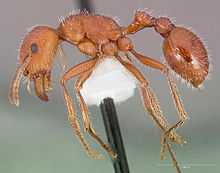Pogonomyrmex maricopa
| Pogonomyrmex maricopa | |
|---|---|
 | |
| P. maricopa worker | |
| Scientific classification | |
| Kingdom: | Animalia |
| Phylum: | Arthropoda |
| Class: | Insecta |
| Order: | Hymenoptera |
| Family: | Formicidae |
| Subfamily: | Myrmicinae |
| Tribe: | Myrmicini |
| Genus: | Pogonomyrmex |
| Species: | P. maricopa |
| Binomial name | |
| Pogonomyrmex maricopa Wheeler, 1914 | |
The Maricopa harvester ant, Pogonomyrmex maricopa, is one of the most common species of harvester ant species found in Arizona, USA.[1] Its venom is believed to be the most toxic insect venom in the world.[2]
Their nest mounds are likely to incorporate rocks and gravel. The ants construct cemented caps on the sand mound nests in a fine sand dune area. The caps are approximately 60% calcium carbonate that is transported from the underlying calcium carbonate layers, and protect the nest structure from being eroded away during high-wind periods. Partial erosion of the cemented caps adds calcium carbonate to the sand dune soils.[3]
Venom and attack method
The toxicity of the venom of the Maricopa harvester ant is well known. Its LD50 value is 0.12 mg/kg (injected intravenously in mice); 12 stings can kill a 2-kg rat. In comparison, the LD50 of the honey bee is 2.8 mg/kg — less than 1/20th as strong. Although the toxicity of the venom of the Maricopa harvester ant is the highest tested for any insect, it pales in comparison to that of the most venomous snake (i.e., the Inland Taipan's venom has an LD50 of 0.01 mg/kg in mice[4]) or the most poisonous frog (i.e., the poison dart frog's toxin has a mean LD50 of 0.0002 mg/kg in mice[5]). In humans, a Pogonomyrmex sting produces intense pain that can last up to four hours.[2][6]
Like that of many venomous insects, the venom of the Maricopa harvester ant consists of amino acids, peptides, and proteins. This may also encompass alkaloids, terpenes, polysaccharides, biogenic amines, and organic acids. The most notable component found in the venom of the Maricopa harvester ant is an alkaloid poison—this releases an "alarm" pheromone that chemically alerts other ants in the vicinity. This is an example of chemical signaling, which explains why ants all appear to sting at once. The venom can also contain allergenic proteins that are otherwise known to set off a potentially lethal immune response in certain victims.
Similar to the two-part process of the fire ant bite and sting, the harvester ant will attach to the victim with its mandibles, and so proceed by pivoting around the site, allowing the ant to repeatedly sting and inject venom into the region.
The Maricopa harvester ant plays a major role in decomposition by dragging dead carcasses of insects underground, thereby enriching soil for plants and crops.
References
- ↑ Harvester Ants (Pogonomyrmex spp.) — Urban Integrated Pest Management
- ↑ 2.0 2.1 W. L. Meyer (1996-05-01). "Chapter 23 — Most Toxic Insect Venom". Book of Insect Records. University of Florida.
- ↑ Whitford, Walter G. (2003). "The functional significance of cemented nest caps of the harvester ant, Pogonomyrmex maricopa". Journal of Arid Environments 53 (2): 281–4. doi:10.1006/jare.2002.1039.
- ↑ Morrison, John; Pearn, John; Covacevich, Jeanette; Tanner, Charles; Coulter, Alan (1983). "Studies on the Venom of Oxyuranus Microlepidotus". Clinical Toxicology 21 (3): 373–85. doi:10.3109/15563658308990428. PMID 6676477.
- ↑ Brief Review of Natural Nonprotein Neurotoxins.
- ↑ Anne Marie Helmenstine. "World's Most Venomous Insect". About.com.
External links
| Wikimedia Commons has media related to Pogonomyrmex maricopa. |